Manu Cloudforest and Amazon Rainforest Extension from Cuzco Improved roads in and out of Cuzco has opened up many new options for travel into this region for Manu tours. One option (see sample itinerary below) for a guided tour is to drive out of Cuzco through the mountains and down into the cloudforest of the Eastern slopes of the Andes. 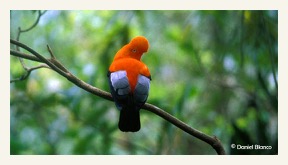 After touring in the cloudforest elevations, we can precede into the lower elevations and explore along the Madre De Dios River and its Amazon rainforest. From there we may drive back to Cuzco via the greatly improved "Interoceanic Highway". Both days driving from and back to Cuzco usually only takes about 6 to 8 hours including short stops along the way. The 5-day itinerary below is a sample of what is possible and practical for a good overview and range of ecosystems and activities. Longer itineraries and the use of different accommodations/lodges are possible. It is also possible to shorten a day or so and we can customize tours based on interests, such as birding, etc.
After touring in the cloudforest elevations, we can precede into the lower elevations and explore along the Madre De Dios River and its Amazon rainforest. From there we may drive back to Cuzco via the greatly improved "Interoceanic Highway". Both days driving from and back to Cuzco usually only takes about 6 to 8 hours including short stops along the way. The 5-day itinerary below is a sample of what is possible and practical for a good overview and range of ecosystems and activities. Longer itineraries and the use of different accommodations/lodges are possible. It is also possible to shorten a day or so and we can customize tours based on interests, such as birding, etc.

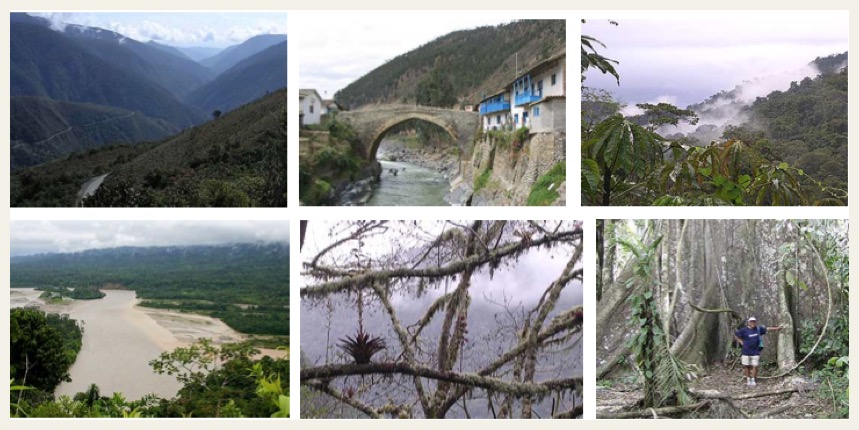
SAMPLE 5-DAY ITINERARY
Day 1: Cuzco - Cloud Forest (B/L/D)
Leaving Cusco early in the morning, we begin an 8-hour journey over the Andes by bus, stopping for a coffee at the beautiful colonial village of Paucartambo. Continuing, we climb to the highpoint of the Manu Biosphere at about 4000 m before descending to the cloud forest. In these mysterious surroundings we take a hike to the lek of the incredible cock-of-the-rock, to see the 'performance' of the males right under our eyes. We spend our first night in the rustic lodge Posada San Pedro (appr. 1,600 m). Located at about 6 hours driving distance from Cusco, between bamboo and short cloud forest trees covered with mosses and bromeliads, the lodge has 4 bungalows with 2 rooms each, a beautiful lounge and separate toilets and hot-water showers. For a couple of hours each evening a generator provides light and the possibility to recharge your batteries. Temperatures are between 18C (75F) during the day and 10C (65F) at night. Together with the high air humidity may wish to use the provided blankets. The surrounding forest holds Woolly- and Brown Capuchin Monkeys, as well as the elusive Spectacled Bear. Here bird species start to fan out into many striking shapes and colors: Andean Cock of the Rock, Umbrella Bird, Versicoloured Barbet, Highland Motmot, Green Jay and many tanagers and hummingbirds. This is also the place to see orchids, begonias, fuchsias, lichens, mosses, bromeliads, bamboo and the primitive tree fern trees.
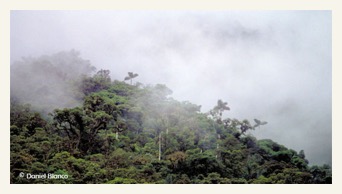
Our overland journey to the Amazon begins at 3,400m/11,150 ft, with an early departure from the highland city of Cusco. Today’s destination is the lush cloud forest region where the Andes fall away to the Amazon basin. This is a day of scenic drama and striking contrasts. We first visit a mountain wetland habitat teeming with migrant and local waterfowl, before crossing two mountain ranges between the Cusco valley and the Paucartambo Valley, to a maximum altitude of 3,900m/12,790ft. Finally we follow a sinuous ribbon of highway on its plunge through an extraordinary world of forested cliffs, waterfalls and gorges. We take leisurely stops to see mountain villages, a hilltop necropolis of chullpas (pre-Inca burial chambers), and the abrupt ridgetop of Ajanaco, which marks the final high point where the Andes begin their swoop into the Amazon basin. In clear weather we will see a breathtaking panorama of cloud forest and mountain giving way to the lowland rainforest plains far below us. After a picnic lunch near here we descend through the startling and rapid environmental transformations characteristic of the tropical Andes, passing from grassland and stunted trees through elfin forest, until we wind through a lush and magical world of overhanging trees, giant ferns, monster begonias, countless orchids and bromeliads, and a diverse and teeming birdlife. We make frequent spontaneous stops, perhaps spotting a brilliantly feathered quetzal, a trogon, or the wild turkey-like Guan, and for a chance to see Peru’s dazzling national bird, the Cock-of-the-Rock (Rupicola). (B/L/D)
Day 2: Cloud Forest - Pantiacolla Lodge (B/L/D)
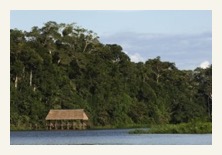
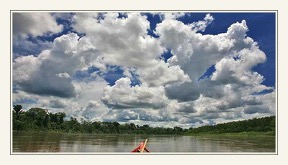
The lodge has 900 hectares of surrounding forest, extending from 350 to 1200m above sea level. There are 8 species of monkey, among which the rare Monk Saki Monkey and the only nocturnal monkey on Earth, the Douroucouli. You can find both Collared- and White-Lipped Peccaries in healthy populations roaming the lodge’s extensive trail system. There is Coati, Tayra, several deer species and cats as Puma, Ocelot and the smaller Margay.
The lodge’s bird list is just shy of 600 species, and you can see an average of 150 species per day. The list includes rare species as the Black Tinnamou, Little Blue Heron, Harpy Eagle, Buckly’s Forest Falcon, Orange-breasted Falcon, Uniform Crake, White-throated Quail Dove, Blue-hooded Macaw, Dark-billed Cuckoo, Long-tailed Potoo, Hairy Crested Ant Bird, Elusive Antpitta, Cinnamon Tyrant-manakin, Cinnamon Flycatcher, Golden-naped Tanager and many others. The lodge has at least 9 distinct forest types, you can visit easily within a couple of days. It varies from lowland varzea, that floods in the rainy season, to bird rich bamboo forest to high, never flooding, terre firme, and isolated cloud forest. There are enormous Kapok Trees, colorful Coral Trees, many different palm trees, Balsa Trees, and growing on the trees are Anthuriums, Dieffenbachias, Monsteras, Elephant’s Ears and on the beach Cecropia Trees, figs, Caña Brava cane and the little Sensitivity plants.
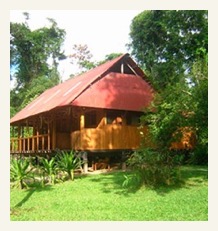
The property has over 26 kilometers of trail surrounding the lodge. The trails take you through the different forest types; the longest of 6 km goes up to 920m above sea level into isolated cloud forest, giving you an impressive view of the Andean Mountain Range. Closer by the lodge, at about 2 hours hiking, you can visit the Petroleo Stream. You will believe you are in a scene of Jurassic Park, with palm trees, tree fern trees, enormous rocks, waterfalls, swimming pools etc. The Monk Saki Trail, at intermediate altitude, gives you a chance of viewing this rare monkey species. The Capybara and Tinnamou Trails down from Pantiacolla Lodge are at about 350m above sea level, where you find the highest wildlife diversity, especially for monkeys and birds. The Sajino Trail makes a loop around Ranacocha, Frog Lake, which is a small lake surrounded by hundreds of frogs. You can also swim or fish in the alto Madre de Dios River and make bonfires on the beach at night. (B/L/D)
Day 3: Pantiacolla - Blanquillo Lodge (B/L/D)
In the morning we take a nature hike on one of the lodge’s many trails. After a final walk through the forest, in the afternoon we take boats down the Madre de Dios River to Blanquillo, near a claylick for macaws, where we spend the night in the jungle lodge Tambo Blanquillo.
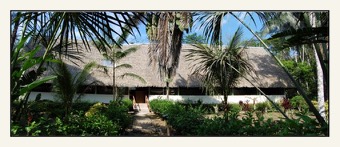
The jungle lodge at Blanquillo is locally known as a Tambo. It is a typical communal jungle building called “maloca”, in which one can feel safe and comfortable and still enjoy the surrounding wildlife. The main Tambo is designed following the architectural guidelines of the native huts (communal houses in the Amazon). The housing is austere but surprisingly comfortable and fresh, thanks to the design of the roof, which beside being high, which aids ventilation, is made of many combed leaves of Shebon a typical palm that grows in the area, which cushions the jungle heat. At night, lighting is provided through solar panels and LED lights that provide the necessary illumination in a discrete approach. There are 20 rooms including doubles, triples and singles, all with very comfortable beds. Bath area is not private but commonly shared, but still retains, sufficient privacy due to its design. Hot water is provided by solar panels.

The new dining room located overlooking the Madre de Dios River, is equipped to accommodate over 40 people, plus a bar area to relax, watch and especially enjoy the beauty of nature and especially at moonrise, where, in combination with fireflies and the sound of nocturnal animals, provide the sensation of being in a magical world of total tranquility. The same feeling you get at sunrise, when the sounds of the awakening forest transport you to never-never land, all due to the extraordinary location of this facility. (B/L/D)
Day 4: Macaw Lick (B/L/D)
At first light we head to the macaw lick to watch the dazzling spectacle of hundreds of parakeets, parrots and big macaws eating clay. In the afternoon we visit another one of Manu's beautiful oxbow lakes and later visit a 42-meter high canopy tower.
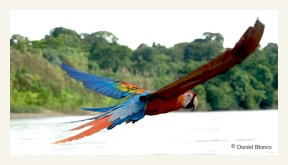
The Blanquillo macaw clay lick is a section of the banks of the Madre de Dios River of 6 meters height and 250 meters long. This area is an early and daily meeting point of several families of orange-cheeked parrot (Pionopsitta barrabandi), blue-headed parrot (Pionus mentrus), mealy parrot (Amazona farinosa) and more small parakeets . A little later arrive, red and green macaws (Ara chloroptera) and the scarlet macaw (Ara macaw); also a common visitor is the piping guan (Pipile cumanensis). Not only birds use this clay wall as a source of needed antacids. Not surprisingly, mammals such as tapirs (Tapirus terrestris), red deer (Mazama americana), howler monkey (Alouatta seniculus) can be found. The act of eating clay performed by these animals is mainly to neutralize their pH, which has been acidified as a consequence of eating green fruits and also to absorb various nutrients of this wonderful clay which are not found in their daily diet.
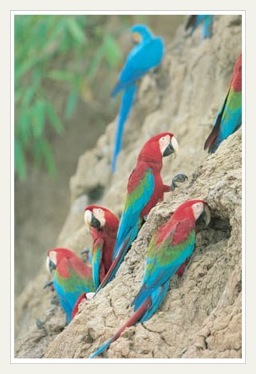
Observation platform or blind is a platform-observatory of 8 meters high and 50 meters long, that can accommodate 100 visitors. This amazing building, very well located only 50 meters from the wall of the clay lick, which allows extraordinary photos of the daily bird activity without the need for very expensive lenses and due to its positioning, it?s possible to take very sharp pictures when the early morning sun light bathes the clay wall. Comfortable swivel chairs and a long table used for equipment support or to take notes ,enables to notice in total tranquility, the stunning work of parrots, macaws, parakeets and other birds and animals attending this clay lick. A hearty breakfast is served in the comfort of this location. To enter, you have to arrive early in the morning (5:20 am) and do a 26 minute walk ( at normal pace) through a trail that crosses a secondary forest, where you can find various species of birds, reptiles, and the possible presence of tapirs, deer, agouti and peccary.
Later, a 10-minute walk through a seasonally flooded transition forest will take us to Blanco Oxbow Lake, by far one of the best rainforests settings in the area. Its environs display different kinds of rainforest habitats and its stagnant waters provide rich nutrients and fish to their usual dwellers, like giant otters and black caimans. In addition, this region displays a number of different microhabitats as a result of ancient rivers moving throughout geological time creating a series of terraces, each containing different types of forest. This mosaic of habitat types (being the tallest the oldest) is one of the reasons these forests are among the richest in the world in terms of biodiversity. A catamaran allows access by paddling around the lake.
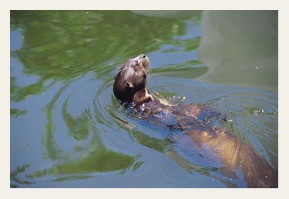
In the late afternoon we visit an observation tower on top of a Kapok tree (Ceiba pentandra). At 50 meters from the ground it provides the highest and most stunning of the entire region of Manu. A steel staircase leads to the observation deck made out of wood. From there you can see the movement of birds, mainly, the macaws early in the morning on their way to the Ccollpa ( Clay Lick). Here you can also see rare species frequently, as the harpy eagle (Harpia harpyja) nesting, or better yet, in full hunt and the king vulture (Sarcoramphus papa) of the jungle. One of the most spectacular views of this tower is towards the Camungo Oxbow Lake, a rich body of water, home to a huge number of birds and other species such as caimans and giant river otters (Pteronura brasiliensis).
We spend the night again in the jungle lodge Tambo Blanquillo. (B/L/D)
Day 5: Blanquillo - Boca Colorado - Cusco (B/L/D)
Back on the boats early in the morning, we head downstream to the small mining village Boca Colorado. During the trip in motorized canoes from Blanquillo there is the opportunity to observe a wide variety of birds, an animals and reptiles sunbathing in the beaches and river banks, being the most commonly found macaws, ducks, caimans and herons. Sometimes if lucky, capibaras and the elusive jaguar can be spotted. Other species sometimes spotted include Osprey, Black Caiman, Roseate Spoonbill, Capybara, and Yellow-headed Sideneck.
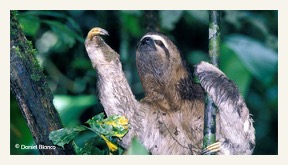
In Mazuco later on, you can see the negative effects of certain human activities on the delicate ecological balance of the rainforest. We take local transportation till crossing the Inambari River. On the other side, our bus is waiting to take you over a newly paved road, through beautiful cloud and elfin forest. Near Cusco as we climb up the Andes, you have stunning views of the Ausangate Mountain. We reach Cusco in the evening and transfer to your hotel for the overnight.
ABOUT MANU NATIONAL PARK
Where is Manu:
Peru’s Manu National Park is in the southwestern corner of the vast Amazon basin. It can be reached from Cusco, the former Inka Capital. Manu makes a perfect combination with a visit to the Inka Citadel Machu Picchu, one of the Wonders of the World. Its limits are reached from Cusco after about 4 hours by car down the Manu Road, but then it will still take you 2 days by car and boat to get to its most pristine heart in Manu’s Reserved Zone.
The vegetation of Manu:
This enormous and well protected park starts with the scarce vegetation of the Andean Puna Grasslands at 4200m above sea level, but vegetation gets bigger in dimension and also denser going down the eastern Andean slope. You pass Elfin Forest, Cloud Forest to reach as low as 350m above sea level of the Lowland Amazon Rainforest with trees as high as 50 meters or more.
Wildlife of Manu:
Puna Grasslands birdspecies include Moustached Flowerpiercer, Shining Sunbeams and Scribble-tailed Canastero.
Elfin Forest, with its tiny trees, is the highest limit for both the Andean Spectacled Bear and the majestic Jaguar, and already has a longer bird list, among which the Blue-banded Toucanet, Golden-headed Quetzal, Marcapata Spinetail, Red-and-white Antpitta, Barred Fruiteater etc.
The Cloud Forest trees are somewhat bigger, up to 10-15 meters, and covered with mosses, lichens and bromeliads. Here we can already find two species of monkey, the Woolly Monkey and the Brown Capuchin Monkey. The Cloud Forest birds have incredible members, such as the Andean Cock of the Rock, the Umbrella Bird and the Crested Quetzal. There are many tanagers and hummingbirds plus Versicoloured Barbet, Highland Motmot and Green Jay. This is a good altitude (apr. 1600m) for butterflies, including members of the Skipper, Daggerwing and Sulphur families.
The Lowland Amazon Rainforest is one of Earth’s most complex and fascinating ecosystems. Just standing in the middle of the forest trying to figure out where plants begin and end and with what other plants and animals they interact is a challenge. Nothing is simple or straightforward in this environment. This entanglement holds about 800 bird species (of the total of 1000 of Manu) and almost all of the 200 mammal species.
The forest is also monkey territory, and you can see the biggest South American monkeys, the Black Spider Monkey and the Woolly Monkeys in healthy populations, interacting with each other, but also with you. The tiniest monkey is the Pygmy Marmoset, or “pocket monkey” and there is the only nocturnal monkey on Earth, the Night Monkey or Douroucouli. You can also see other mammals in the forest, but you never know if that will be a raccoon as the Coati or the Tayra, a weasel species, or the Southern Tamadua, which is an anteater, or maybe one of those wild cats as Ocelot or Margay. The forest birds include Razor-billed Curassow, Spectacled Owl, Amazonian Pygmy-Owl, Cream-coloured Woodpecker, Pavonine Quetzal, Black-spotted Bare-eye, Gouldi’s Antbird, Rufous-fronted Antthrush, Spangled Cotinga, Musician Wren, Casqued Oropendola, Opal-crowned Tanager in the forest. Among the butterflies, the Riodinids, Nymphalids and Satyrids are particularly prolific here.
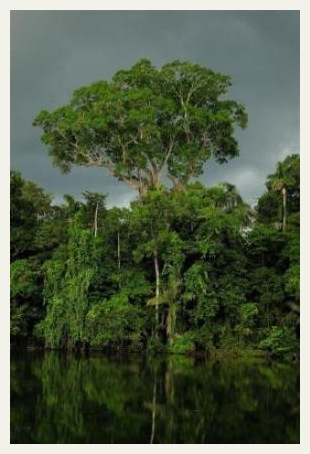
Along the banks of the river you can see Capybara, the biggest rodent on Earth, and crossing animals such as may be peccaries, deer, Tayra or even Howler Monkeys. After a cold spell, jaguars love to warm up in the first sun rays on the beaches. The river bird species include Roseate Spoonbill, the enormous Jabiru, Horned-Screamer, Osprey and Black Skimmer. If river conditions are suitable we will look out for butterflies imbibing moisture from sandbanks. Sometimes these aggregations can run into many hundreds of individuals – a beautiful sight.
The lakes are Giant Otter and Black Caiman territory, both large animals on the verge of extinction due to habitat destruction. On the lakes you always see the Hoatzin “punk bird”, Moscovy Duck, Neotropical Cormorant and Snake Bird. The claylicks, “collpas” give you a spectacle of many parakeet, parrot and macaw species, among which the Tui Parakeet, White-Eyed Parakeet, Blue-Headed Parrot, Orange-Cheeked Parrot, Red-and-Green Macaw and Scarlet Macaw.
History of the park
For long, Manu was populated by indigenous peoples, who found various and ingenious ways to survive in its beautiful but hostile environment. After Spanish conquest of South America, mission posts and big “tropical haciendas” (farming communities led by colonists and worked by indigenous people) were the first outside organizations to meddle in Manu’s daily life.
In the 1970’s, Manu was established as a National Park by the Peruvian Government. The National Park status is the only one in this country that gives nature 100% protection, so this was an important moment for Manu’s future. A couple of years later it was first included in UNESCO´s Man and the Biosphere (MAB) Programme and in 1987 it was acknowledged as a "World Heritage Site". Manu is internationally acclaimed as one of the most biodiverse areas on Earth. Eco-tourism to Manu has been promoted as of the 1980’s of last century to Manu’s Reserved and Cultural Zone. It is the only economical activity for Manu’s Reserved Zone and the only sustainable activity of Manu’s Cultural Zone
Manu National Park and Manu Biosphere Reserve, what is the difference?
The Manu Biosphere and the Manu National Park are oftentimes confused. The Manu Biosphere Reserve includes two areas, the Manu National Park, with full protection, and a buffer zone, Manu’s Cultural Zone that still has a certain level of protection. The Cultural Zone is around the Alto Madre de Dios River and includes most of its tributaries. Then Manu National Park is divided into two areas as well, the intangible part, beyond the guard post of Pakitza on the Manu River, and the area that allows controlled tourism, the Reserved Zone.
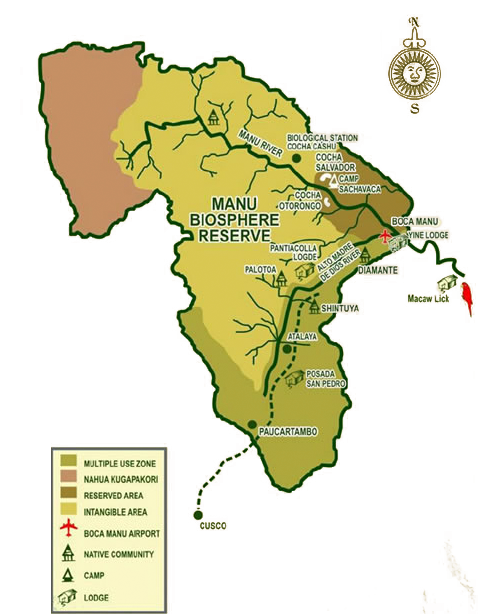
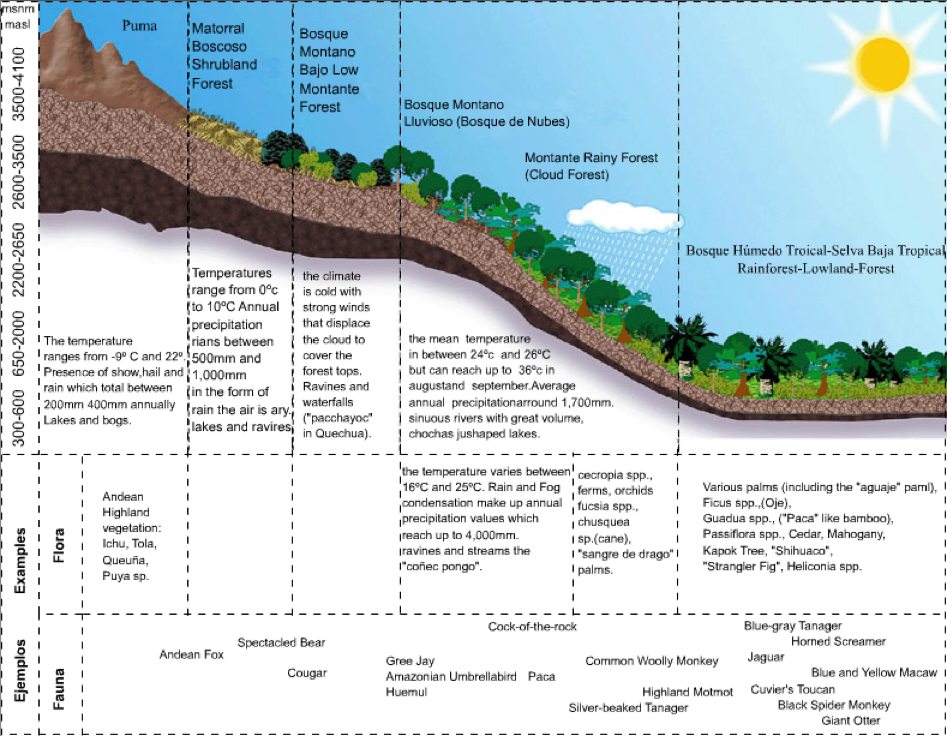
You are welcome to call us anytime at 1-239-992-9660, or toll free at 800-446-9660.
Return to the top of this webpage :)
